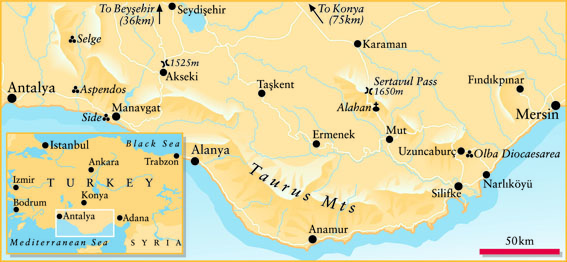The Seljuk Han of Anatolia
SERTAVUL HAN
Located in the famous Sertavul pass through the Taurus Mountains, this han had an intriguing inscription, now lost.
|
Karpuz, Anadolu Selçuklu Eserleri (2008) v.1, p. 392. |
|
photo: Scott Redford |
|
|
 map courtesy of Cornucopia Magazine, Issue 31, 2004 |
|
photograph of the now lost inscription taken by Unal in 1973 |
DISTRICT
33 MERSIN
LOCATION
36.9083138, 33.2641754
The Sertavul Han is located 38 km from Mut on the Karaman-Silifke highway in a dramatic setting at the Servavul pass, the highest point of the Taurus Mountains. It is located on a route between Karaman and the valley of the Gok Su River, which linked central Anatolia with Cilicia and the Mediterranean coast.
The Sertavul Pass (1,660 m/ 5,446 ft) is a famous mountain pass situated in the Taurus mountains at the border of the Mersin-Karaman province. This pass is covered with snow in the winter making its crossing challenging and dangerous. For this reason two hans were built at a distance of 5km, one on the Mut side and one on the Karaman side. The Sertavul Pass is on the road from Konya down to the Mediterranean Sea and which arrives there either at Anamur or Silifke. This was the location where the Holy Roman Emperor Frederick I Barbarossa crossed the Taurus Mountains on the Third Crusade and drown while crossing the Calycadnus (Goksu) River.
36.9083138,33.2641754
NAMES
Mut-Sertavul Han
Serdavul Han
DATE
It cannot be confirmed if it had been built during the time of Alaeddin Keykubad I or later, during the Karamanoğlu period. However, many researchers believe that it was built during the era of Alaeddin Keykubad I, in view of the inscription (now lost) and the architectural style, similar to other Seljuk hans such as the Tol Han.
INSCRIPTION
A fragmentary inscription found in this han was published by Unal in 1973, who also took an excellent photo of it.
This ruined han contained a fragmentary inscription which included the name of the emir who built the han, Banak bin ‘Abd Allah, as well as the person responsible for the construction, a certain Yavi. The patron was an emir of slave origin, as denoted by his name, “Son of Allah”, which is a conventional title for converts to Islam. As per Redford, this patron may very well be the same Banak mentioned on an inscription on the walls of the Ehmedek citadel of Alanya (1227), which would argue for a construction date of the han of @1220-30.
The inscription has since gone missing since it was photographed by Ünal. This inscription is particularly interesting in that it has a Greek inscription at the bottom of the stone block. It is not certain if this inscription is part of a reuse spolia block or was carved anew, like the bilingual inscription on the Sinop walls (1215), the only surviving Seljuk bilingual inscription known.
BUILDING TYPE
Covered open courtyard (COC)
DESCRIPTION
The han is now in ruins, and only a few arches remain. The the han had a rectangular covered section with two ribbed barrel vaults running longitudinally
The han was in good condition through the 1950's. After this period, it fell into disrepair and its inscription plaque was lost. The inscription plaque is reported to be located in the garden of the Sertavul Gendarme Station.
BIBLIOGRAPHIC REFERENCES
Karpuz, Haşim. & Kuş, A. & Dıvarcı, I. & Şimşek, F. Anadolu Selçuklu Eserleri, 2008, v.1, p. 392.
Özergin, M. Kemal. “Anadolu’da Selçuklu Kervansarayları”, Tarih Dergisi, XV/20, 1965, pp. 161, n. 108.
Redford, Scott. "Reading inscriptions on Seljuk Caravanserais: A mari usque ad mare". Cultura visuale e materiale dall’Adriatico all’India, Eurasiatica 4, 2016, pp. 221-234. (includes a reproduction of the inscription originally published by Ünal).
Ünal, Rahmi Hüseyin. "Deux caravansérails peu connus de l’époque pré-ottomane au sud de Karaman (Konya)". Art and Archaeology Research Papers, 3, 1973, pp. 59-69.
©2001-2025, Katharine Branning; All Rights Reserved.